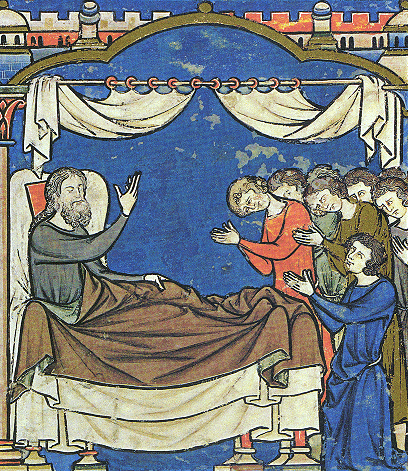The stories of Abraham, Jacob and Isaac in the Old Testament provide clues that, when paired with archaeological evidence, determine a date for when they would have happened.
Looking at the text of Genesis alongside archeological clues, scholars can make an informed guess as to when the events concerning Abraham and the other Old Testament patriarchs would have occurred.
In the beginning, God created the heaven and the earth…which in turn led to a debate about when the events of Genesis, the first book of the Bible, took place. There’s also a controversy about if the events took place as well, but Israel Finkelstein and Neil Asher Silberman, in their book The Bible Unearthed: Archaeology's New Vision of Ancient Israel and the Origin of Its Sacred Texts, wisely avoid that. The authors skip right over Adam, Eve, Cain, Abel, Noah, et al., jumping to the patriarch Abraham.
“What are the clues that the old way of dating Genesis was off by about 1,500 years?”
Until somewhat recently, biblical scholars landed on a date of about 2100 BCE for Abraham’s departure for Canaan. But Finkelstein and Silberman argue that archaeological evidence actually points to the events in Genesis matching up to the history of the 7th to 6th centuries BCE. What are these clues that the old way of dating Genesis was off by about 1,500 years?
Camel caravans, mentioned in Genesis, didn’t happen before the 8th century BCE.
Camels
As odd as it might seem, the camels mentioned throughout these stories reveal a major clue. Camels weren’t domesticated as beasts of burden in the ancient Near East until well after 1000 BCE. And caravans described as carrying gum, balm and myrrh in the Joseph story wouldn’t have been familiar until the Arabian trade flourished under the Assyrian Empire in the 8th and 7th centuries BCE.
The Philistine king of Gerar returns Sarah to Abraham.
The Philistines
These much-mentioned people of the Old Testament didn’t migrate from the Aegean or eastern Mediterranean until sometime after 1200 BCE. And it wasn’t until the late 8th and 7th centuries BCE that Gerar, identified today as Tel Haror, became a heavily fortified Assyrian administrative stronghold.
Jacob, described as an Aramean in Genesis, doles out his blessings to his male offspring, dividing up the land into the 12 tribes of Israel.
The Arameans
Arameans, who dominate the stories of Jacob and his two wives, Leah and Rachel, and his Uncle Laban, weren’t mentioned as a distinct ethnic group in ancient Near East texts until 1100 BCE or so. They became a dominant factor in the region in the early 9th century BCE. The history of early Israel and Aram are bound up together. In fact, “much of the population of the northern territories of the kingdom of Israel seems to have been Aramean in origin,” Finkelstein and Silberman write. Indeed, Jacob is even described at one point as “a wandering Aramean.” It wasn’t until the 9th to 8th centuries BCE that the two kingdoms created an official border.
Fatherly deathbed blessings must have been common at the time. Here’s Isaac with his firstborn, Esau, who should have gotten his father’s birthright.
Jacob and Esau
In Genesis, Esau was the eldest son of Isaac, and by rights should have been given his father’s birthright. But his mother, Rebecca, preferred her younger son, Jacob, and tricked her husband into bestowing his blessing on Jacob instead. Even though that was a shady move, it explains how Israel and its people are God’s chosen people. Esau, a hunter and outdoorsman, represents the more primitive land of Edom, while Jacob, sensitive and cultured, represents Israel. The kingdom of Edom, in what’s now southern Jordan, didn’t exist until the late 8th century BCE, reaching a peak in the 7th and early 6th centuries BCE.
Judah, seen here tempted into sex with his disguised daughter-in-law Tamar (that’s a whole other story), got the best kingdom of the bunch from Jacob: the region that was home to what was then the small town of Jerusalem.
Judah
On his deathbed, Jacob doled out a bunch of blessings to his male offspring, who would disperse into the 12 tribes of Israel. But Judah was the one who received the royal birthright, described in Genesis 49:8-10. The eponymously named kingdom of Judah remained isolated and sparsely populated until the 8th century BCE. Its capital was then a small, remote hill town with a name you might have heard before: Jerusalem.
“Yet after the northern kingdom of Israel was liquidated by the Assyrian empire in 720 BCE, Judah grew enormously in population, developed complex state institutions, and emerged as a meaningful power in the region,” Finkelstein and Silberman write. “It was ruled by an ancient dynasty and possessed the most important surviving Temple to the God of Israel.”
All of this evidence points to the fact that the rise of the people of Israel, including the famous patriarchs Abraham, Isaac, Jacob and Judah, would have lived around the 7th and 6th centuries BCE — and not 2100 BCE as previously theorized. –Wally


























